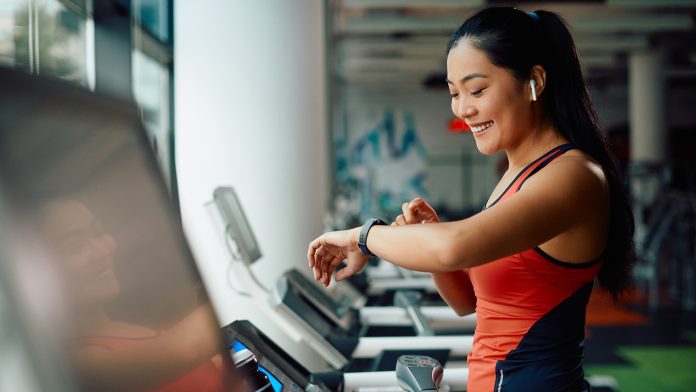
University of Cambridge researchers have developed a method of measuring fitness levels on wearable devices, without the need of exercising.
Normally, tests to accurately measure VO2 max, which is a key measure of overall fitness level and an important predictor of heart disease and mortality risk, require expensive laboratory equipment and are mostly limited to elite athletes. The new method uses Machine Learning to predict VO2 max during everyday activity, without the need for contextual information such as GPS measurements.
VO2 max is a scientific way of measuring aerobic fitness. VO2 max is the maximum amount of oxygen that your body can use during exercise. It is known as the ‘gold standard’ of fitness tests.
The research was published in npj Digital Medicine.
The largest study of its kind to look at fitness levels and wearable devices
Within the largest study of its kind, the researchers gathered activity data from over 11,000 participants in the Fenland Study using wearable sensors, with a further cohort tested again seven years later.
The researchers used to data to develop a model that predicts VO2 max, which was validated against a third group that carried out a standard lab-based exercise test. The model provided highly accurate results when compared to the lab-based data.
Currently, many smartwatches and wearable devices boast about their ability to estimate VO2 max. However, it is relatively unknown how accurate they are. Whereas, the Cambridge model provides accurate predictions based on heart rate and accelerometer data. The model can detect changes in fitness levels over time, meaning it could be a powerful tool in estimating fitness levels for entire populations and identifying lifestyle trends.
“VO2 max isn’t the only measurement of fitness, but it’s an important one for endurance and is a strong predictor of diabetes, heart disease, and other mortality risks,” said co-author Dr Soren Brage from Cambridge’s MRC Epidemiology Unit. “However, since most VO2 max tests are done on people who are reasonably fit, it’s hard to get measurements from those who are not as fit and might be at risk of cardiovascular disease.”
“We wanted to know whether it was possible to accurately predict VO2 max using data from a wearable device so that there would be no need for an exercise test,” said co-lead author Dr Dimitris Spathis from Cambridge’s Department of Computer Science and Technology. “Our central question was whether wearable devices can measure fitness in the wild. Most wearables provide metrics like heart rate, steps or sleeping time, which are proxies for health, but aren’t directly linked to health outcomes.”
Using wearable devices to deliver accurate fitness data
The participants wore wearable devices continuously for six days. The sensors gathered 60 values per second, resulting in a wide range of data before processing.
“We had to design an algorithm pipeline and appropriate models that could compress this huge amount of data and use it to make an accurate prediction,” said Spathis. “The free-living nature of the data makes this prediction challenging because we’re trying to predict a high-level outcome (fitness) with noisy low-level data (wearable sensors).”
The team used an Artificial Intelligence model known as a deep neural network to process and extract vital data from the raw sensor data and make predictions of VO2 max from it. Furthermore, the models could identify sub-populations in need of intervention relating to fitness levels.
The Machine Learning model had a strong agreement with the measured VO2 max at both baseline (82% agreement) and follow-up testing (72% agreement).
“This study is a perfect demonstration of how we can leverage expertise across epidemiology, public health, Machine Learning and signal processing,” said co-lead author Dr Ignacio Perez-Pozuelo.
The researchers suggested that their results demonstrate how wearables can accurately measure fitness levels, but transparency needs to be improved if measurements from commercially available wearables are to be trusted.
“It’s true in principle that many fitness monitors and smartwatches provide a measurement of VO2 max, but it’s very difficult to assess the validity of those claims,” said Brage. “The models aren’t usually published, and the algorithms can change on a regular basis, making it difficult for people to determine if their fitness has actually improved or if it’s just being estimated by a different algorithm.”
“Everything on your smartwatch related to health and fitness is an estimate,” said Spathis. “We’re transparent about our modelling and we did it at scale. We show that we can achieve better results with the combination of noisy data and traditional biomarkers. Also, all our algorithms and models are open-sourced and everyone can use them.”
“We’ve shown that you don’t need an expensive test in a lab to get a real measurement of fitness – the wearables we use every day can be just as powerful, if they have the right algorithm behind them,” said senior author Professor Cecilia Mascolo from the Department of Computer Science and Technology. “Cardio-fitness is such an important health marker, but until now we did not have the means to measure it at scale. These findings could have significant implications for population health policies, so we can move beyond weaker health proxies such as the Body Mass Index (BMI).”







